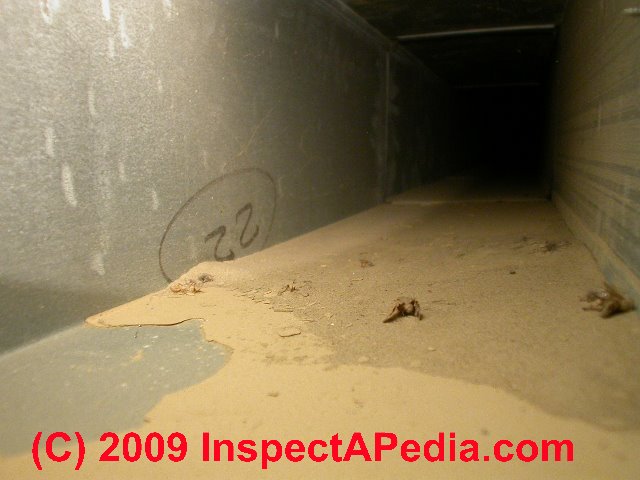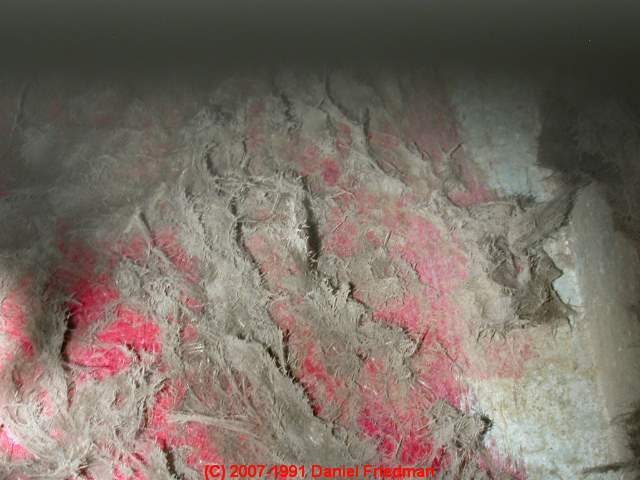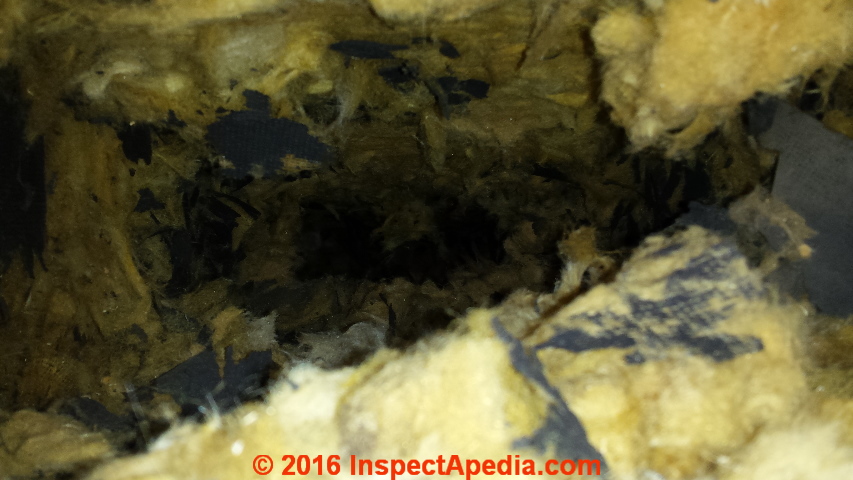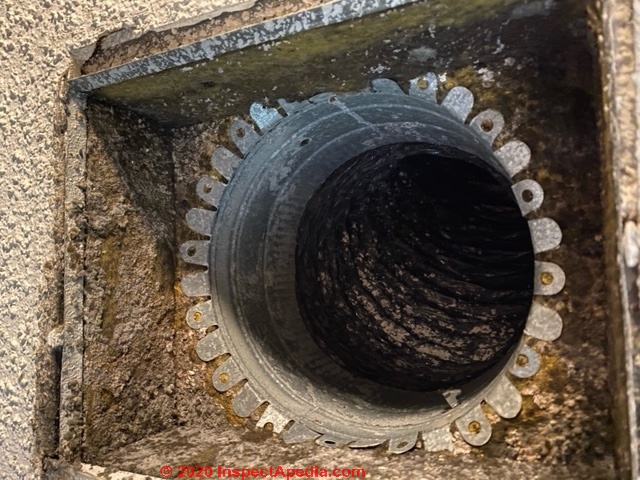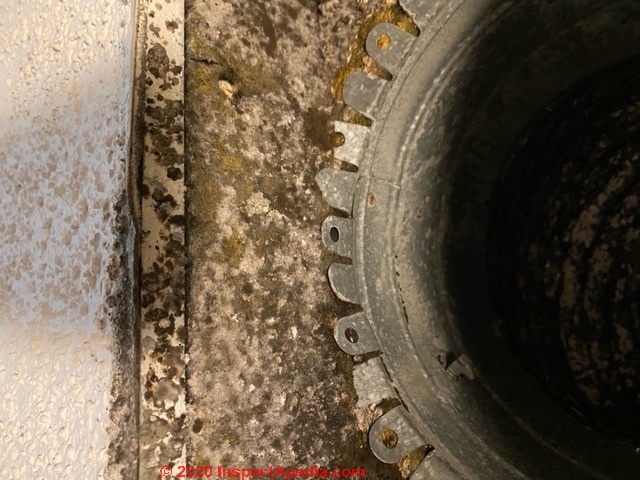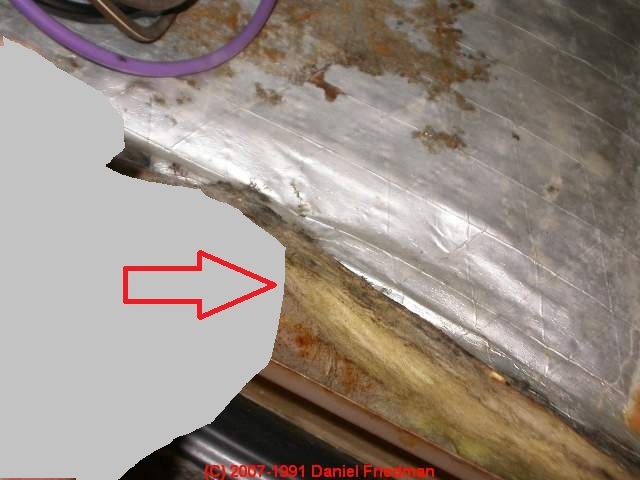 Clean Mold-contaminated Fiberglass HVAC Ducts?
Clean Mold-contaminated Fiberglass HVAC Ducts?
Cleaning Advice for Moldy HVAC Ducts & Fiberglass Duct Insulation
- POST a QUESTION or COMMENT about Mold in Air Ducts: cause, detection, cure, & prevention of moldy HVAC ductwork
Advice for cleaning contaminated HVAC ducts:
This article gives advice on the cleaning of mold-contaminated air ducts in buildings.
This article series explains the cause, detection, and hazards of mold growth in fiberglass insulation in residential and light-commercial building and gives advice about dealing with moldy building insulation or ductwork.
Page to photo: water and mold stains on foil faced insulation in an HVAC air handler blower compartment.
InspectAPedia tolerates no conflicts of interest. We have no relationship with advertisers, products, or services discussed at this website.
- Daniel Friedman, Publisher/Editor/Author - See WHO ARE WE?
Advice for Suspected or Known Mold-Contamination in HVAC Ductwork (Air ducts, heating ducts, air conditioning ducts)
 Some types of ductwork can and should be cleaned while other types of HVAC duct cannot be effectively cleaned and are at risk of being destroyed by aggressive cleaning efforts.
Some types of ductwork can and should be cleaned while other types of HVAC duct cannot be effectively cleaned and are at risk of being destroyed by aggressive cleaning efforts.
If those ducts are badly contaminated they should be replaced.
Just above is a photograph of white or light gray mold growth on the interior surface of a fiberglass-lined air duct. The yellow lines show where we applied adhesive tape to collect a mold test sample.
While more investigation was required, we speculated that the Atlanta Georgia home where this duct mold was found had either suffered water or high moisture in the ductwork or there had been another source of high levels of Aspergillus, Penicillium, and perhaps other molds in the building's indoor air.
High exposure levels, or repeated exposure to high levels of this type of airborne mold can cause serious illness such as Aspergillosis.
See ASPERGILLOSIS for details.
Details of this air duct mold contamination study are found
at FIBERGLASS AIR DUCT MOLD TEST.
Should You Clean Flooded, Contaminated, or Moldy Air Ducts?
If visual inspection, possibly supported by testing (not usually required) confirms that the interior of an air conditioning or heating duct system is badly soiled or contaminated with high levels or large areas of asbestos, mold, rodent feces or urine, insect fragments such as cockroach parts, or other allergens or pathogens then the movement of building air through the duct system is likely to distribute those particles into air breathed by building occupants.
The actual hazard level of such ductwork can be difficult to determine. Air testing in the building or in the ductwork might confirm high levels of hazardous particles but if it doesn't that is not an assurance that the ductwork is safe, since the level of airborne particles varies enormously depending on when and how a test is performed and on variations in building conditions.
If HVAC ducts have been flooded (photo below) or exposed to sewage leaks they should be cleaned and sanitized, or replaced completely if the ductwork is a type that cannot be cleaned.
At WATER & ICE IN DUCT WORK you will find more advice for cleaning ductwork subjected to flooding
Only Metal Ductwork May be Able to Be Cleaned
Metal HVAC ducts like the ductwork shown above, whose insulation is on the duct exterior and that present a simple metal surface on the duct interior can usually be successfully cleaned by a duct cleaning professional.
Fiberglass Lined HVAC Ducts & Flex-Duct Can Not be Safely Cleaned by Mechanical Means
Watch out: Fiberglass lined ductwork may be seriously damaged by mechanical cleaning, increasing the subsequent release of irritating airborne fiberglass particles into building air and actually reducing the resistance of such ductwork to future debris and moisture and even mold accumulation.
Both of the photos above show mechanically-damaged fiberglass on the inside of air ducts. More about mechanically-damaged HVAC air ducts is at DUCT DAMAGE, MECHANICAL.
Other badly contaminated ductwork such as flex-duct, moldy fiberglass-lined or fiberglass-panel ductwork should be replaced. And in any case you should address the cause of mold growth and correct that as well or the problem will simply repeat itself.
HVAC Duct Cleaning Advice from the US EPA - supplemented by additional expert opinion
If you think the heating or air conditioning (HVAC) system may be contaminated with mold, read the EPA's guide
SHOULD YOU HAVE the AIR DUCTS in YOUR HOME CLEANED? [PDF]
before taking further action. Retrieved 2016/11/12, original source: www.epa.gov/iaq/pubs/airduct.html, or call the US EPA at (800) 438- 4318 for a free copy.
Turn off Air Conditioning or Heating Systems That are Mold-Contaminated
The U.S. Environmental Protection Agency recommends that you do not run contaminated air conditioning or heating systems (that use forced air and air ducts).
Watch out: in addition to the EPA advice given here, you should not run HVAC systems in buildings known to be contaminated with anything that is likely to be airborne, as doing so virtually assures that the interior of the HVAC system is going to become also contaminated if it wasn't already in that condition.
Here is the US EPA advice - excerpted:
“Do not run the HVAC system if you know or suspect that it is contaminated with mold - it could spread mold throughout the building”. [1]
Buildings in areas where high humidity and high use of air conditioning such as Florida and Louisiana in the U.S. experience very high levels of condensate produced by the air conditioning system, so high that condensate sometimes blows into the ductwork itself rather than all draining successfully into the condensate drain system. According to the Florida Department of Health:
Unfortunately, it is thought that most, if not all, heating and air conditioning systems in Florida will support mold growth at some point.
Stopping the use of an air conditioning system due to suspected mold growth would make most Florida buildings very uncomfortable during hot and humid weather.
Should you turn off an air conditioner if a mold problem in the system is found? Ideally, yes. The system should be shut down while cleaning or mold removal is performed.
If the water and/or mold damage was caused by sewage or other contaminated water, then call a professional who has experience cleaning and fixing buildings damaged by contaminated water. [2]
Watch out: the U.S. EPA and other sources recommend: [among other details found in the articles listed in ourReferences or Citations ] that
Have your air ducts cleaned if they are visibly contaminated with substantial mold growth, pests or vermin, or are clogged with substantial deposits of dust or debris.
EPA Advice on Using Biocides, Sanitizers & Ozone to Treat Contaminated HVAC Ducts
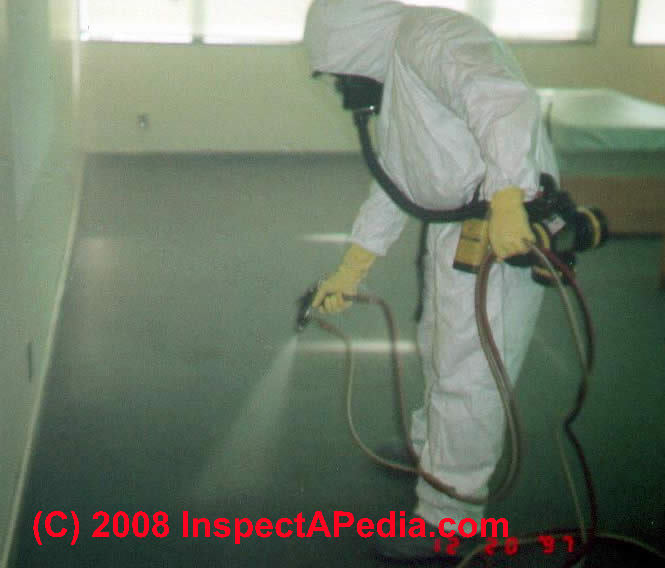 Watch out: we do not recommend relying on ozone treatments to "clean" or "disinfect" HVAC ducts, and there is question about the effectiveness of both ozone and sanitizers or chemical biocides used in ductwork.
Watch out: we do not recommend relying on ozone treatments to "clean" or "disinfect" HVAC ducts, and there is question about the effectiveness of both ozone and sanitizers or chemical biocides used in ductwork.
Here are excerpts from the EPA document:
Air duct cleaning service providers may tell you that they need to apply a chemical biocide to the inside of your ducts to kill bacteria (germs), and fungi (mold) and prevent future biological growth.
Some duct cleaning service providers may propose to introduce ozone to kill biological contaminants.
Ozone is a highly reactive gas that is regulated in the outside air as a lung irritant. However, there remains considerable controversy over the necessity and wisdom of introducing chemical biocides or ozone into the duct work.
Among the possible problems with biocide and ozone application in air ducts:
Little research has been conducted to demonstrate the effectiveness of most biocides and ozone when used inside ducts. S
imply spraying or otherwise introducing these materials into the operating duct system may cause much of the material to be transported through the system and released into other areas of your home.
Some people may react negatively to the biocide or ozone, causing adverse health reactions.
See FUNGICIDAL SEALANT USE GUIDE for details
See OZONE MOLD / ODOR TREATMENT WARNINGS for a summary of the problems that ensue, particularly from over-treatment using ozone in buildings.
...
Reader Comments, Questions & Answers About The Article Above
Below you will find questions and answers previously posted on this page at its page bottom reader comment box.
Reader Q&A - also see RECOMMENDED ARTICLES & FAQs
Question: will vacuuming out my ducts stop dust accumulation?

This Hallway vent was constantly accumulating dust …somewhat afraid due to Codina /Delta
It was vacuumed out and now appears to be this set up
It looks like some sort of fan -not sure
Please see photo below and please let me know your opinion
Will this stop the dust from accumulating ?
appreciate your expertise, Tks - Anonymous by private email 2021/09/23
Moderator reply: no
Sorry but I know absolutely nothing about your building and its mechanicals system so I'm pretty limited in what I can guess;
That looks like an air return register, with a rather-small return air opening; usually a supply register has operable louvers that open or close.
About what you think may be a fan, I can't see enough to say what's there; if it's a fan and is operating you'd see its blades moving and feel air movement at the register.
It is good practice to clean dirty heating or air conditioning ducts and registers as they can, if left dirty, become a reservoir for mold, allegens, pathogens.
Cleaning ducts alone isn't likely to cure troublesome indoor dust levels. You may see dust in HVAC ducts and at registers but unless they're made of or contain damaged insulation they're not a dust source; they're a dust collector or dust transporter.
So if there is or are or were abnormal dust sources in your building that dust may be picked up by and moved around by the HVAC duct system.
A good air filter system in your air handler or at return registers, combined with regular filter maintenance (clean or change the filters) can make a significant difference in indoor dust levels.
See details starting
at AIR FILTERS for HVAC SYSTEM
Also be sure to read
You might also want to do some reading starting at
Question: what caused the dark sooty deposits at the supply register & across my ceiling ?
Please take a look and advise if possible thank you so much. - Anonymous by private email, 2020/11/16
Moderator reply:
The ductwork in your photos is very moldy, with almost certainly multiple genera/species of mold.
Worse news is that neither flex duct nor that rigid fiberglass ductwork that I think we see around the register can be cleaned.
Watch out: You will need to
- inspect the entire HVAC system including not just ductwork but also the air handler, blower compartment, blower fan itself, return and supply registers (inlets and outlets) for visible mold
- clean hard surfaces that can be cleaned (such as metal surfaces)
- replace materials that can't be cleaned such as flex duct and fiberglass duct liners
At DUCT DAMAGE, MECHANICAL we explain why it's not possible to successfully clean fiberglass ductwork
- find and fix the cause of this mold growth
- check more-widely for mold: you may want to have a competent inspector examine the home for mold contamination and leaks.
I advise against simple "mold tests" as inaccurate and unreliable and because the test won't change what's needed anyway when we can see mold contamination.
When there is more than 30 sq.ft. of contiguous moldy material you need a professional cleaning company to perform the work.
Question: any lawsuits or class action over HVAC insulating duct boards?
Are there any type of lawsuits for duct boards?
Insurance won't pay anything for the remediation of my home and I am at a loss on where to even start - no one seems to be able to tell me the source of my leak or what has caused the contamination or how long I've had the mold growth.
I am now being told my whole house needs to be remediated because it's blown throughout the duct work for who knows how long and the levels are off the charts. Maggie
Reply:
Maggie,
I'm doubtful that lawsuits are the best place to start attacking the problem you describe.
I'd start by hiring either an experienced building inspector or HVAC system technician to diagnose the problem you face, including its cause, providing evidence and documentation, not just "opinion" lest you get nowhere. If necessary you may need an independent insurance adjuster to help out.
From just your note we don't know what contamination is the concern, nor how we know what's been blown through the building, at what levels, and causing what need for further cleaning.
Reader followup
Thanks Dan. I have actually had all the mold testing along with air samples done and that's how I know it's all throughout my house. I have the type of mold and the counts etc. The insurance adjuster is coming to see if there's any possibility of them paying for any of it - but they say there's slim to no chance of them paying for any of it and if they do it is a minimal amount of the cleanup.
I am in the process of getting estimates from 3 mold remediation companies and an estimate from a HVAC company for replacement of the duct board and/or whole system. I spoke to a real estate agent about "resale" values and the effect of mold in the home and he is actually the one who suggested researching if there were any lawsuits relating to duct boards since insurance doesn't pay for anything etc. I did a google search but came up with nothing. The cost is very prohibitive to wanting to get your house clean so it's all pretty discouraging.
Reply:
If your HO policy excludes mold damage you're not covered.
WATCH OUT: DO NOT allow a superficial inexpert "cleanup" if in fact there is a large area of mold contamination - inexpert work may further spread contamination and require still more professional and costly cleanup. Before proceeding with cleanup you need a reliable mold remediation plan defining the scope of work, containment, etc.
Maggie said:
Yes the insurance company came out today to do their inspection and nothing is covered. I have 4 companies coming tomorrow to provide me with quotes. Two of them work with insurance companies all the time and are supposed to be two of the top mold removal companies (Rainbow Intl and ServPro) the other is Advanta and the 4th is AAS Restoration.If you've heard of any of these companies and have any reviews or thoughts on them I would appreciate any feedback. I've read Angies list reviews and other online reviews and really haven't seen too many bad reviews on any of them.
I also had a duct cleaning service come in that was NADCA certified and they were telling me about some type of service that they spray and paint and the manufacturer of the product guarantees no new regrowth or old leaks of mold for 10 years.
I'm guessing this would be the cheapest but not sure if it is the most effective. If you have an opinion on that too I would appreciate your input. ServPro also told me they use a different testing company because the mold inspection company I used tends to be very "over the top" with their recommendations.
For instance because my readings on the 3rd floor were high they suggested having the whole house HEPA vaccumed. ServPro suggested the whole house may not require "total cleaning"
He stated some companies will then try to tell you you have to have absolutely everything cleaned or thrown away - like sheets, clothes and if you have a stuffed animal it would be thrown away.
Tables could be cleaned but some furniture couldn't - so sometimes the "over the top" recommendations are not necessary and companies may try to get me to do more than necessary. Not sure if you have thoughts on that either but if I do the minimum cleaning - in other words replace duct work clean extremely high level areas with HEPA vacuuming etc. how much damage will I leave if I don't HEPA clean whole house.
I of course realize these are all broad opinions on items that you are not seeing or reports you are reading. Thank.
Reply: "throw everything away" is usually inappropriate advice
I agree with your ServPro rep that "throw everything away" is usually inappropriate advice. Some items such as hard surface items are usually easily cleaned; some soft goods can be laundered or drycleaned. Other items such as water damaged carpets, padding, drywall, upholstered couches are tossed out.
...
Continue reading at AIRBORNE PARTICLE & MOLD LEVELS in DUCTWORK or select a topic from the closely-related articles below, or see the complete ARTICLE INDEX.
Or see these
Recommended Articles
- AIRBORNE PARTICLE & MOLD LEVELS in DUCTWORK where we describe how to test HVAC systems and ductwork for mold.
- BLOWER LEAKS, RUST & MOLD for Readers concerned with mold contamination in heating and air conditioning air handlers and ductwork
- DUCT CLEANING ADVICE
- DUCT DAMAGE, MECHANICAL
- MOLD APPEARANCE - WHAT MOLD LOOKS LIKE for help in recognizing what mold looks like in buildings.
- MOLD APPEARANCE - STUFF THAT IS NOT MOLD for examples of stuff sometimes mistaken for mold
- MOLD GROWTH in AIR HANDLERS
- TAPE & BULK SAMPLING & TESTS for MOLD on how to use tape to sample settled dust or suspected mold growth.
- WATER & ICE IN DUCT WORK - advice for cleaning ductwork subjected to flooding
- WHY DOES MOLD GROW in INSULATION?
Suggested citation for this web page
DUCT CLEANING ADVICE at InspectApedia.com - online encyclopedia of building & environmental inspection, testing, diagnosis, repair, & problem prevention advice.
Or see this
INDEX to RELATED ARTICLES: ARTICLE INDEX to MOLD CONTAMINATION & REMEDIATION
Or use the SEARCH BOX found below to Ask a Question or Search InspectApedia
Ask a Question or Search InspectApedia
Try the search box just below, or if you prefer, post a question or comment in the Comments box below and we will respond promptly.
Search the InspectApedia website
Note: appearance of your Comment below may be delayed: if your comment contains an image, photograph, web link, or text that looks to the software as if it might be a web link, your posting will appear after it has been approved by a moderator. Apologies for the delay.
Only one image can be added per comment but you can post as many comments, and therefore images, as you like.
You will not receive a notification when a response to your question has been posted.
Please bookmark this page to make it easy for you to check back for our response.
IF above you see "Comment Form is loading comments..." then COMMENT BOX - countable.ca / bawkbox.com IS NOT WORKING.
In any case you are welcome to send an email directly to us at InspectApedia.com at editor@inspectApedia.com
We'll reply to you directly. Please help us help you by noting, in your email, the URL of the InspectApedia page where you wanted to comment.
Citations & References
In addition to any citations in the article above, a full list is available on request.
- SHOULD YOU HAVE THE AIR DUCTS IN YOUR HOME CLEANED [PDF] U.S. Environmental Protection Agency, Indoor Environments Division, EPA-402-K-97-002, web search 8/5/11, original source: http://www.epa.gov/iaq/pdfs/airducts.pdf
- INDOOR MOLD AND HEALTH, A FUNGUS AMONG US [PDF] Florida State Department of Health, Florida Department of Health
Division of Environmental Health
Bureau of Community Environmental Health
Radon and Indoor Toxics
4052 Bald Cypress Way, Bin A08
Tallahassee, FL 32311
1-850-245-4288
1-800-543-8279, web search 08/05/2011, original source: http://www.doh.state.fl.us/environment/community/indoor-air/Indoor_Mold_and_Health.pdf. Quoting:
The Florida Department of Health has developed this brochure to address some of the most common questions and concerns about indoor mold, how it affects human health, and ways in which you can prevent or remove it. - [3] Mark Cramer Inspection Services Mark Cramer, Tampa Florida, Mr. Cramer is a past president of ASHI, the American Society of Home Inspectors and is a Florida home inspector and home inspection educator. Mr. Cramer serves on the ASHI Home Inspection Standards. Contact Mark Cramer at: 727-595-4211 mark@BestTampaInspector.com 11/06
- [5] Ahearn, D.G., S A Crow, R B Simmons, D L Price, J A Noble, S K Mishra and D L Pierson, "Fungal colonization of fiberglass insulation in the air distribution system of a multi-story office building: VOC production and possible relationship to a sick building syndrome", Journal of Industrial Microbiology & Biotechnology, Volume 16, Number 5 (1996), 280-285, DOI: 10.1007/BF01570035.
Abstract:
Complaints characteristic of those for sick building syndrome prompted mycological investigations of a modern multi-story office building on the Gulf coast in the Southeastern United States (Houston-Galveston area).
The air handling units and fiberglass duct liner of the heating, ventilating and air conditioning system of the building, without a history of catastrophic or chronic water damage, demonstrated extensive colonization with Penicillium spp and Cladosporium herbarum.
Although dense fungal growth was observed on surfaces within the heating-cooling system, most air samples yielded fewer than 200 CFU m–3. Several volatile compounds found in the building air were released also from colonized fiberglass.
Removal of colonized insulation from the floor receiving the majority of complaints of mouldy air and continuous operation of the units supplying this floor resulted in a reduction in the number of complaints. - [6] Ahearn, D.G., S.A. Crow, R.B. Simmons, D.L. Price, S.K. Mishra and D.L. Pierson, "Fungal Colonization of Air Filters and Insulation in a Multi-Story Office Building: Production of Volatile Organics", Current Microbiology Volume 35, Number 5 (1997), 305-308, DOI: 10.1007/s002849900259,
Abstract:
Secondary air filters in the air-handling units on four floors of a multi-story office building with a history of fungal colonization of insulation within the air distribution system were examined for the presence of growing fungi and production of volatile organic compounds.
Fungal mycelium and conidia of Cladosporium and Penicillium spp. were observed on insulation from all floors and both sides of the air filters from one floor.
Lower concentrations of volatile organics were released from air filter medium colonized with fungi as compared with noncolonized filter medium.
However, the volatiles from the colonized filter medium included fungal metabolites such as acetone and a carbonyl sulfide-like compound that were not released from noncolonized filter medium.
The growth of fungi in air distribution systems may affect the content of volatile organics in indoor air. - [7] Price,D. L., R. B. Simmons, I. M. Ezeonu, S. A. Crow and D. G. Ahearn, "Colonization of fiberglass insulation used in heating, ventilation and air conditioning systems", Journal of Industrial Microbiology & Biotechnology Volume 13, Number 3 (1994), 154-158, DOI: 10.1007/BF01584000,
Abstract:
The number of fungal species colonizing thermal and acoustic fiberglass insulations used in heating, ventilation, and air conditioning (HVAC) systems was fewer than that obtained from initial direct culture of these insulations.
The colonization, determined by the microscopic observation of conidiophores with conidia, was primarily of acrylic-latex-facing material, but eventually the fungi permeated the fiberglass matrix.
Isolates of Aspergillus versicolor were most often obtained from non-challenged insulation, whereas Acremonium obclavatum appeared to be the primary colonizing fungus in high-humidity (>90%) challenge chambers.
At a lower humidity (about 70%) Aspergillus flavus was one of the more prominent fungi.
Not all duct liner samples were equally susceptible to colonization and duct board appeared relatively resistant to colonization. - [8] Simmons, R. B. and S. A. Crow, "Fungal colonization of air filters for use in heating, ventilating, and air conditioning (HVAC) systems", Journal of Industrial Microbiology & Biotechnology Volume 14, Number 1 (1995), 41-45, DOI: 10.1007/BF01570065, Abstract:
New and used cellulosic air filters for HVAC systems including those treated with antimicrobials were suspended in vessels with a range of relative humidities (55–99%) and containing non-sterile potting soil which stimulates fungal growth.
Most filters yielded fungi prior to suspension in the chambers but only two of 14 nontreated filters demonstrated fungal colonization following use in HVAC systems.
Filters treated with antimicrobials, particularly a phosphated amine complex, demonstrated markedly less fungal colonization than nontreated filters.
In comparison with nontreated cellulosic filters, fungal colonization of antimicrobial-treated cellulosic filters was selective and delayed. - [9] Ifeoma M. Ezeonu, Daniel L. Price, Sidney A. Crow and Donald G. Ahearn, "Effects of extracts of fiberglass insulations on the growth of Aspergillus fumigatus and A. versicolor", Mycopathologia Volume 132, Number 2 (1995), 65-69, DOI: 10.1007/BF01103777
, Abstract:
Water extracts of thermal and acoustic fiberglass insulations used in the duct work of heating, ventilation and air conditioning (HVAC) systems supported germination of conidia and growth of Aspergillus versicolor (Vuillemin) Tiraboschi 1908–9 and Aspergillus fumigatus Fresenius 1863.
Urea, formaldehyde and unidentified organics were detected in the extracts.
Formaldehyde in concentrations similar to those found in the extracts restricted the growth of both species in enriched media.
A. versicolor, the more common species associated with fiberglass insulations, was more resistant to formaldehyde than A. fumigatus. - In addition to citations & references found in this article, see the research citations given at the end of the related articles found at our suggested
CONTINUE READING or RECOMMENDED ARTICLES.
- Carson, Dunlop & Associates Ltd., 120 Carlton Street Suite 407, Toronto ON M5A 4K2. Tel: (416) 964-9415 1-800-268-7070 Email: info@carsondunlop.com. Alan Carson is a past president of ASHI, the American Society of Home Inspectors.
Thanks to Alan Carson and Bob Dunlop, for permission for InspectAPedia to use text excerpts from The HOME REFERENCE BOOK - the Encyclopedia of Homes and to use illustrations from The ILLUSTRATED HOME .
Carson Dunlop Associates provides extensive home inspection education and report writing material. In gratitude we provide links to tsome Carson Dunlop Associates products and services.


